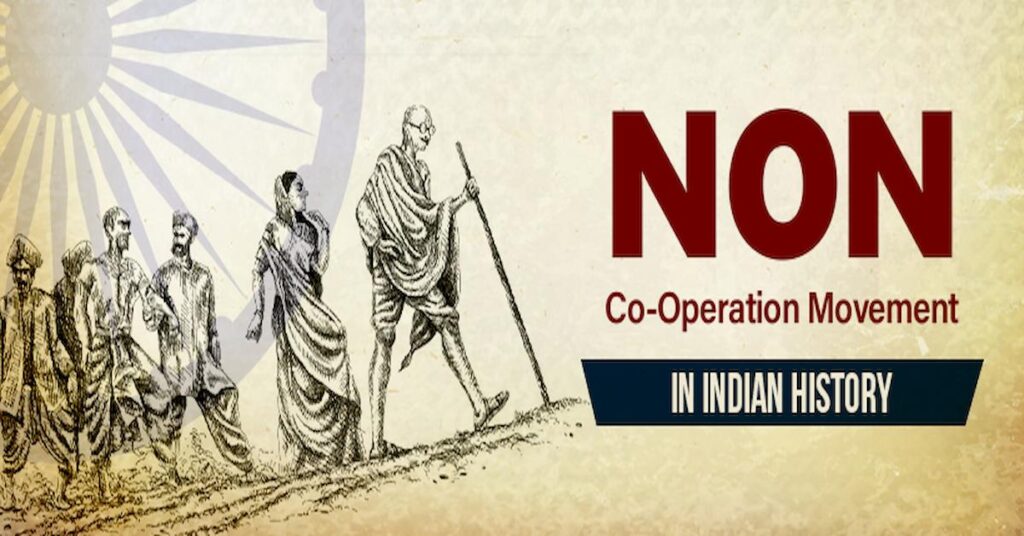Non-Cooperation Movement:
The Non-cooperation movement was shipped off on the fifth of September 1920 by the Indian National Congress under the drive of Mahatma Gandhi. In September 1920, in a congress meeting in Calcutta, the party introduced the non-coordinated effort program. The Non-joint effort movement was shipped off following the events of the Jallianwala Bagh Massacre.


Credits: study24x7
No tax campaign:
No-obligation campaigns get the innovative brains of the workers. Gandhi pronounced a no-cost campaign in Bardoli in February 1922. These improvements inconceivably redesigned Gandhi’s remaining as a public boss, especially the laborers.
Gandhi made a cross-country visit. Students who remained in government occupations, students gave up their assessments for an enormous scope. e Prince of Wales’s visit to India was productive.
During this boycott, specialist organizations and workers participated. In any case, Gandhi, out of the blue, took out the advancement considering the Chauri Chaura event.
Swarajists:
Congress was isolated into two get-togethers, strong of transformers and no-transformers. Part of the Congressmen driven by Motilal Nehru and C.R. Das expected to challenge races and enter the administering body.
They fought that the public interest could be promoted by working in the Legislative Councils under Dyarchy and wrecking the Colonial government.
They were called “strong transformers.” A couple of allies of Gandhi, like Vallabhbhai Patel, C. Rajaji, and others, known as no-transformers, are expected to continue the non-joint effort with the government.
C.R. Das and Motilal Nehru molded the Swaraj party in January 1923, which was upheld by a phenomenal gathering of the Congress. Swaraj party people were picked in enormous numbers for the Imperial Legislative Councils. A while later, they revealed the genuine substance of the Colonial government.
In any case, the Swaraj Party began to decline after the death of its boss, C.R. Das, in 1925. A piece of the Swaraj party began to recognize government work environments. The Swaraj Party pulled out from the gathering in 1926.
Constructive program of Gandhi:
After the Chauri Chaura incident, Gandhi felt that the specialists and people should be ready for a serenity fight. In a piece of this work, he focused on promoting Khadi, Hindu-Muslim fortitude, and the invalidation of distance.
With the coordinated effort of the Hindus and Muslims during the Khilafat Movement and the Non-investment Movement, the fortitude was fragile.
Hindu Mahasabha was gaining in noticeable quality under Madan Mohan Malaviya and the Muslim League under the Ali Brothers. Gandhi embraced a 21-day and in-center between 1924 and 1925 to address the hearts of the Hindus and Muslims and drew them in with shared legislative issues.
Boycott of the Simon Commission:
On November 8, 1927, the British Government announced the course of action of the India Statutory Commission. Made up of seven people headed by Sir John Simon it came to be ordinarily known as Simon Commission.
It was an all-white commission with no Indians. Indians were frustrated that they had been denied the choice to pick their constitution.
All fragments of India, including the Congress and the Muslim League, decided to boycott the commission. Any spot the commission went there to battle, and dull pennant strolls with the brand name ‘Bring Simon back’. The battles were barbarously gone after by the police.
Nehru report:
The Simon boycott joined the different philosophical gatherings in India. An all-party gathering was held in 1928 to move toward a constitution for India as a choice rather than the Simon Commission’s recommendation.
A gathering under the drive of Motilal Nehru was outlined to approach the guidelines given by which the Constitution was to be drafted. The Nehru Report recommended, as,
- Dominion status for India.
- Reservation of seats for Muslims in the Central Legislature and in domains where they are in a minority and for the Hindus in the North-west Frontier Province where they were in the minority.
- The game plan of urgent opportunities, and boundless adult foundations.
Conclusion:
As a piece of this non-cooperation improvement, new products were boycotted and stress was laid on the use of swadeshi things. This provoked a lessening in the import of new materials and gave a lift to the Indian textile industry.
